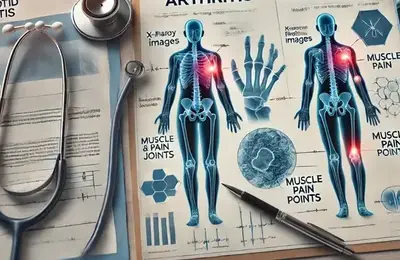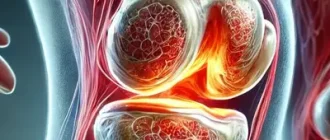Rheumatoid arthritis (RA) and fibromyalgia are both chronic conditions that can significantly affect a person’s quality of life. Despite some overlapping symptoms, such as pain and fatigue, they are fundamentally different in their causes, mechanisms, and treatments. Understanding these differences is crucial for accurate diagnosis and effective management.
Prevalence of RA vs Fibromyalgia by Gender
| Condition | Prevalence (%) |
|---|---|
| Rheumatoid Arthritis (Women) | 75% |
| Rheumatoid Arthritis (Men) | 25% |
| Fibromyalgia (Women) | 80% |
| Fibromyalgia (Men) | 20% |
Causes and Mechanisms
Rheumatoid Arthritis
RA is an autoimmune disease in which the body’s immune system mistakenly attacks the lining of the joints (synovium). This results in inflammation, pain, and eventual joint damage. The exact cause is not fully understood, but factors such as genetics, smoking, and infections can increase the risk of developing RA.
Fibromyalgia
Fibromyalgia is a neurological condition characterized by widespread pain, fatigue, and tenderness in the muscles and soft tissues. Unlike RA, fibromyalgia does not involve inflammation or joint damage. Researchers believe it is linked to the way the brain processes pain signals, often triggered by physical or emotional stress, infections, or trauma.
Symptoms: Spot the Differences
While both conditions cause pain and fatigue, the nature and distribution of symptoms differ significantly.
Rheumatoid Arthritis Symptoms
- Joint Pain and Swelling: Typically affects smaller joints, such as those in the hands and feet, often symmetrically.
- Morning Stiffness: Lasts for more than an hour and improves with movement.
- Fatigue: Caused by systemic inflammation.
- Joint Deformities: In advanced cases, permanent damage and deformities may occur.
Fibromyalgia Symptoms
- Widespread Pain: Felt all over the body, often described as aching, burning, or stabbing.
- Tender Points: Specific areas of tenderness, such as the neck, shoulders, and lower back.
- Chronic Fatigue: Can be severe and unrelated to inflammation.
- Cognitive Issues: Commonly known as “fibro fog,” affecting memory and concentration.
Symptoms Overlap vs Unique Symptoms
| Symptom Type | Percentage of Patients (%) |
|---|---|
| Overlap (e.g., fatigue, widespread pain) | 60% |
| Unique to RA (e.g., joint swelling, deformities) | 30% |
| Unique to Fibromyalgia (e.g., tender points, fibro fog) | 40% |
Diagnosis
How is Rheumatoid Arthritis Diagnosed?
RA is diagnosed through a combination of clinical examination, imaging, and lab tests:
- Blood Tests: Rheumatoid factor (RF) and anti-CCP antibodies are often present.
- Inflammation Markers: Elevated ESR and CRP levels.
- Imaging: X-rays, MRI, or ultrasound to detect joint damage and inflammation.
How is Fibromyalgia Diagnosed?
Fibromyalgia lacks a definitive test. Diagnosis is typically based on:
- Symptom History: Widespread pain lasting more than three months.
- Tender Point Exam: Identifying specific areas of tenderness.
- Exclusion of Other Conditions: Ensuring no underlying diseases are causing the symptoms.
Treatments: Tailored Approaches
Rheumatoid Arthritis Treatment
- Medications:
- Disease-modifying antirheumatic drugs (DMARDs), such as methotrexate.
- Biologic therapies targeting specific immune pathways.
- Nonsteroidal anti-inflammatory drugs (NSAIDs) and corticosteroids for symptom relief.
- Lifestyle Changes: Regular exercise, balanced diet, and physical therapy.
- Surgical Options: Joint replacement for severe cases.
Fibromyalgia Treatment
- Medications:
- Antidepressants like amitriptyline and duloxetine.
- Anti-seizure drugs such as pregabalin (Lyrica).
- Over-the-counter pain relievers for mild symptoms.
- Non-Pharmacological Approaches:
- Cognitive-behavioral therapy (CBT).
- Exercise programs, such as low-impact aerobic activities.
- Stress management techniques.
RA and Fibromyalgia Treatment Effectiveness
| Treatment Type | Effectiveness (%) |
|---|---|
| DMARDs (RA) | 80% |
| Biologic Therapies (RA) | 85% |
| Antidepressants (Fibromyalgia) | 60% |
| Anti-Seizure Drugs (Fibromyalgia) | 50% |
| Cognitive Behavioral Therapy (Fibromyalgia) | 70% |
Prognosis
Rheumatoid Arthritis
With early diagnosis and proper treatment, RA’s progression can be slowed, and joint damage minimized. However, untreated RA can lead to severe complications, including joint deformities and cardiovascular issues.
Fibromyalgia
Fibromyalgia is not progressive and does not cause tissue or joint damage. However, its chronic nature can affect mental health and quality of life. Managing triggers and adhering to treatment plans can significantly improve symptoms.
RA Inflammation Markers vs Fibromyalgia Pain Points
| Characteristic | Prevalence in Patients (%) |
|---|---|
| Elevated ESR/CRP (RA) | 90% |
| Positive RF/Anti-CCP (RA) | 80% |
| Tender Points (Fibromyalgia) | 75% |
| Widespread Pain (Fibromyalgia) | 85% |
Did You Know?
RA is more common in women than men, with a ratio of 3:1. Similarly, fibromyalgia disproportionately affects women, with approximately 80% of cases diagnosed in females.
Sources: American College of Rheumatology, Fibromyalgia Network
Editorial Advice
If you’re experiencing symptoms of RA or fibromyalgia, consult a rheumatologist or a pain specialist for an accurate diagnosis. Early intervention can make a significant difference in managing both conditions. Remember, the right combination of medical treatment and lifestyle adjustments can help you lead a fulfilling life.
About the Author
Reyus Mammadli is the author of this health blog since 2008. With a background in medical and biotechnical devices, he has over 15 years of experience working with medical literature and expert guidelines from WHO, CDC, Mayo Clinic, and others. His goal is to present clear, accurate health information for everyday readers — not as a substitute for medical advice.







